Chinese Name: 莲花山 Pronunciation: Liánhuā Shān
Elevation: 108 meters
Opening Hours: 7:00-17:00
Suggested Visiting Hours: 2-3 Hours
Occupied Area: 2.33 square kilometers
Address: No. 18 Ximen Road, Shilou Town, Panyu District, Guangzhou, Guangdong Province, China
| Tourists | Ticket Fare |
| Adults ( aged 19-59) |
54 yuan |
| Children (1.3 meters to 1.5 meters) |
27 yuan |
| Minors (aged 7-18, with valid ID card) |
27 yuan |
| Seniors (aged 60-64, with valid ID card) |
27 yuan |
1. Children less than 6 years(including 6 years)or below 1.2 meters(including 1.2 meters) are free of charge.
2. Senior citizens over 65 years old(including 65 years) with valid ID card are free of charge.
1. The admission fare of the Lotus Pagoda is 2 yuan per person.
2. The fare of battery cars inside Lotus Mountain is 10 yuan per person.
3. The fare of the Eagle Cliff Cableway is 1 yuan per person.
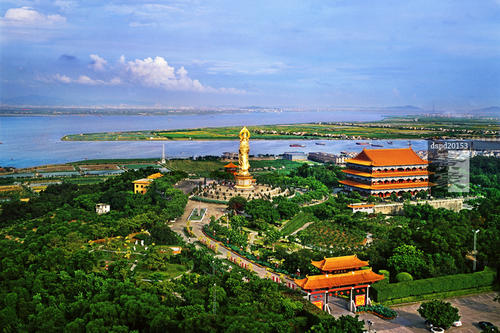
Lotus Mountain is situated in the Panyu District, 30 kilometers away from Guangzhou and 110 kilometers away from Hong Kong, China. Standing beside the Pearl River Delta, Lotus Mountain consists of 48 low mountains of red sandstone and is characterized by the typical Danxia landform.
Lotus Mountain had been a quarry site because of its special structure. Undergoing quarrying work for thousands of years, the cliffs and the caves of the mountains have formed the special scenery. Nowadays, it has been developed into a national 4A level scenic spot under provincial protection.
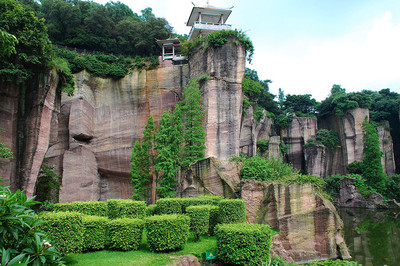
Lotus Mountain was once a quarry site and is still well preserved now. The formation of the landscapes was the hard work of people in the past dynasties who continued to split the mountains to take stones with simple tools, such as chisels and hammers.
Visiting the Ancient Quarry Relics, visitors will be surprised by its strange and giant rocks. Among them, the Swallow Rocks serves as the highlight of the whole relics. Groups of swallows build their nests between the gaps of stones, and it is thus named after the swallow.
Besides, there is another famous cliff named Eagle Cliff. Looking from the cliff, visitors could see fine farmlands arranged regularly and the beautiful landscape of Lotus Mountain.
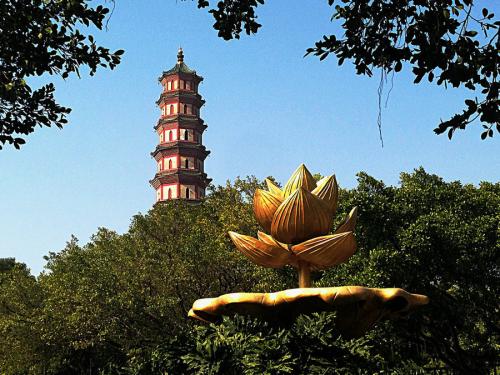
Standing on the main peak of Lotus Mountain, the Lotus Pagoda was built in the 40th year of Wanli Reign in Ming Dynasty (1368-1644). With a history of nearly 400 years, it is now a cultural relic under provincial protection. There are 11 stories inside the pagoda. It is 50 meters high, becoming the highest point of Lotus Mountain as well as a representative of the mountain.
The pagoda had experienced vicissitudes and was bombarded during wartime in the 1930s. In 1981 and 1997, with the financial support of compatriots from Hong Kong and Macao, the pagoda was restored.
When visiting the pagoda, tourists can admire the traditional eight-corner brick architecture. It is also a good choice for them to climb the pagoda, and they will experience a bird view of the Pearl River.
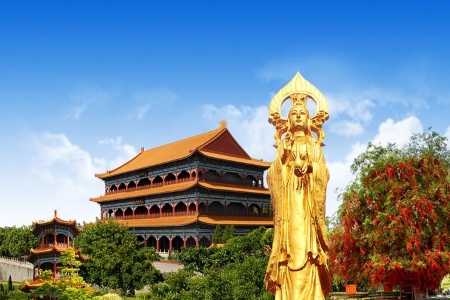
As a holy land of Buddhism, Lotus Mountain is also a good place to worship or learn Buddhist culture. A bronze-made Guanyin statue facing the southeast direction stands inside the scenic spot. Guanyin, also known as the Goddess of Mercy, is believed to save the masses from suffering.
The statue, completed in 1994, is 40.88 meters high. It is cast with 120 tons of bronze and covered with 9,000 grams of gold. The statue is the tallest bronze Guanyin statue covered with gold foil in the world.
It is said that there was a story about Guanyin and the name of Lotus Mountain. Thousands of years ago, an evil dragon lived in the South China Sea. It made waves in the Pearl River, making farmlands flooded and vessels toppled over. The residents were suffering from endless disasters. Knowing that, Guanyin decided to end the misery. She threw her lotus seat to tame the dragon. As the old story goes, the lotus seat turned into a lotus stone, safeguarding this mountain and people living here. That was why the mountain is named Lotus Mountain.
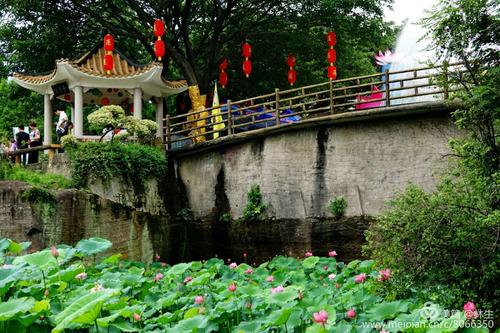
In Summer days (from June to August), the Lotus Flower Festival is held in Lotus Mountain Scenic Spot annually. During this period, the mountain will be decorated into a paradise of gorgeous lotus flowers, and tourists can enjoy more than 100 kinds of lotus. Therefore, it is the best time for lotus fans to visit.
Besides, there is also another big day for flower fans, Peach Blossom Festival. The festival is also held annually. During the Spring Festival in China, visitors can enjoy the blooming flowers, saying “hello” to the coming spring. Therefore, it is the best time for foreign visitors to experience the atmosphere of a Chinese traditional festival while admiring the beauty of flowers.
1. If you climb Lotus Mountain in summer, please bring the anti-mosquito spray with you.
2. Summer days are hot and there is little shade for climbers, so make sure that you have prepared umbrellas, sun-protective clothing, and enough water to prevent you from suffering sunstroke.
3. If you climb Lotus Mountain in winter, please wear warm clothes.
Enter the scenic spot from the West Gate →Lotus Lake →Lotus Pagoda →Lotus City→ Bronze Guanyin Statue →Ancient Quarry Relics → Exit from the North Gate
Take bus Pan 92 or Pan 128 and get off at Lotus Mountain Station, and the fare is 2 yuan.
Take bus Pan 93 and get off at Lotus Mountain Station, and the fare is 3 yuan.
Chinese: 请带我去莲花山。English: Please take me to Lotus Mountain.
If you go to Lotus Mountain from the center of Guangzhou (China Hotel), it takes about 1 hour (about 150 yuan).
If you go to Lotus Mountain from Guangzhou Railway Station, it takes about 1 hour (about 150 yuan).
If you go to Lotus Mountain from Guangzhou East Railway Station, it takes about 1 hour (about 130 yuan).
If you go to Lotus Mountain from Guangzhou West Railway Station, it takes about 1 hour (about 150 yuan).
If you go to Lotus Mountain from Guangzhou South Railway Station, it takes about 1 hour (about 100 yuan).
If you go to Lotus Mountain from Guangzhou North Railway Station, it takes about 2 hours (about 270 yuan).
If you go to Lotus Mountain from Guangzhou Baiyun International Airport, it takes about 1.3 hours (about 200 yuan).
